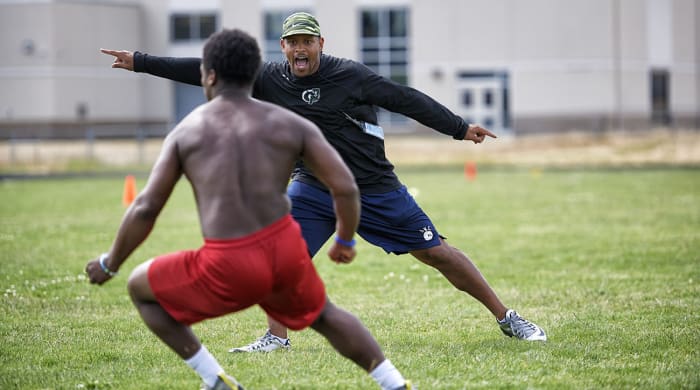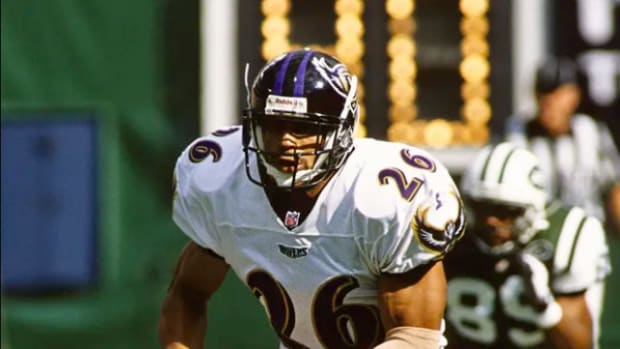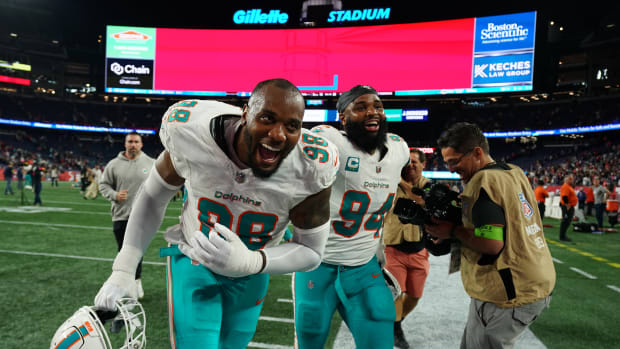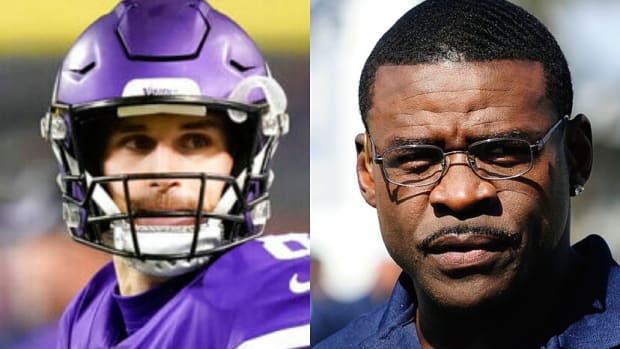‘Active Shooter!’ How Life Put Keanon Lowe Where He Was Supposed to Be
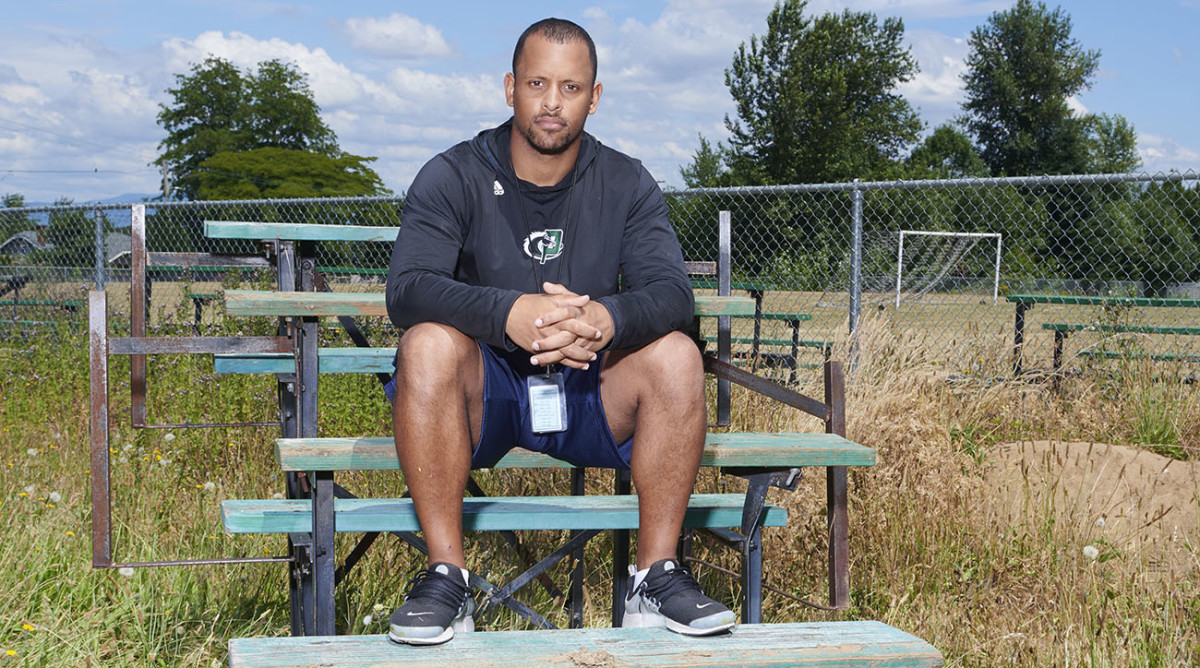
This story appears in the Aug. 26–Sept. 2, 2019, issue of Sports Illustrated. For more great storytelling and in-depth analysis, subscribe to the magazine—and get up to 94% off the cover price. Click here for more.
Keanon Lowe woke up early on May 17 at his modest house in northeast Portland. He drank coffee, ate a bagel and an apple, and drove his dented Jeep Cherokee to Parkrose High, a big school in an economically challenged part of town, where he let football players into the weight room and started preparing for Day 2 of the conference track meet.
By 8 o'clock he’d settled into a cramped, sparsely decorated office adjacent to the cafeteria. At 27 he was coaching Parkrose’s football and track teams, two low-paying gigs made palatable only by his full-time job as a campus security guard. He shared this space with the school’s other unarmed watchmen, one of whom he told to go ahead and take his lunch first. Then, at 11:30, 20 minutes after the fourth-period bell, the call came: “Can you go get Angel Granados-Diaz from the Fine Arts Building and bring him to the counselor's office?”
Lowe sighed. The guards always grumbled about the walk to what they called the “Fab building,” a couple hundred feet away from the main school, out near the athletic fields. He went on his way, though, alternately joking with students about prom and reminding them to get to class. The sun beamed. He remembers seeing groundskeepers lining a softball field, remembers opening the Fab door, remembers noticing a student step out of the boys’ restroom and quickly pop back inside.
At first Lowe went to the wrong room, Mr. Hume’s Health class. He wanted Mr. Melzer’s Government room, and eventually he found it down the hall, where a substitute teacher was in charge. Lowe asked the sub about Granados-Diaz, an 18-year-old senior, when the door opened and a mop-haired kid in glasses and a black trench coat burst in, setting off screams from the students.
Angel Granados-Diaz—the same kid from the bathroom; the same teenager Lowe had been sent to retrieve—stood within arm’s reach. And he was carrying a shotgun.
Keanon Lowe grew up in the Portland suburb of Gresham, eight miles west of Parkrose. He was a mild-mannered and observant boy, someone who looked for responsibilities to shoulder and always watched over everybody else. When Jennifer Lowe gave birth to another son, Trey, it was Keanon who held her hand through labor. He was seven.
Over the years Jennifer adopted a family motto to explain to her kids why, for example, money was sometimes tight. Or why their father, Kevin, moved out around the time Keanon was nine. (Keanon would reconnect with his father in high school.) You are where you’re supposed to be, she’d say. And for Keanon that often meant on a football field. While Jennifer “worked her a-- off”—Keanon's words—as an accountant for a software company to pay private school tuition, Keanon started in 2006 at Jesuit High, near Nike’s headquarters, where he met Dominique Forrest and Taylor Martinek, who would become two of his best friends.
The trio bonded instantly, and between sleepovers they transformed the Crusaders into a gridiron force. Forrest and Martinek were the hard-hitting linebackers. Lowe was the receiver-running back who scored what seemed like a million times. When their careers culminated in the 2009 Class 6A state championship game and Lowe racked up six TDs in a losing effort, recruiters salivated. Among them: Oregon coach Chip Kelly, who visited Jesuit and found not just a 5' 9" offensive threat with elite speed and sure hands but one who was equally respected by his football coaches and his math teachers.
Lowe came to realize he didn’t always have to be so serious. In Martinek, his opposite—a bro, quick with jokes, who made allies easily and rarely stressed—he saw what life might be like if he unwound a little. Still, “Keanon was like the dad of the group,” says his older sister, Alisa Depp. When Alisa dropped out of college, it was Keanon, still in high school, imploring her to keep out of trouble, to not get pregnant.
Faced with his pick of pretty much any big-time West Coast school, Lowe accepted a scholarship at Oregon, where he endured Kelly’s early challenges—“You will never play a f----ing down,” he screamed early on, after Keanon missed a voluntary workout—and rose to meet the coach’s notoriously exacting standards. He embraced the former military instructors who paced the Ducks through Navy SEALs workouts, sprinting between drills as Oregon built the fastest offense in college football and climbed the national rankings. Meanwhile, Lowe befriended blue-chippers, like quarterback Marcus Mariota, and hung out with the walk-ons, channeling his inner, looser Martinek.
Lowe scratched his way into a role on the kickoff coverage team, then at receiver, then, before his senior year, he was chosen by his teammates to be a captain. He’d travel around the state on open weekends to watch his old friends play in college—Forrest at Division III Linfield, Martinek at Portland State—then go back to emulating them off the field at UO. And it worked. Ayele Adika, a running back alongside Lowe for five years, remembers he “could move people’s hearts and [they] followed him.” Lowe, says Kelly, “transcended all classes, all races, all socioeconomic backgrounds; he just fit in.”
Kelly taught his players that “pressure is what you feel when you don’t know what you’re doing.” He told them to never flinch, and when he left in 2013 to coach the NFL’s Eagles he promised he would always try to take care of his old charges. “That program molded my life and shaped my mentality,” Lowe says. “I’m glad Chip yelled at me. I deserved it. He taught me to act and not think.”
Lowe’s playing career concluded like so many others: He went out on a high, catching the first TD in a College Football Playoff national championship game, a loss to Ohio State in January 2015, and then faced the harsh realities of The End. He resolved to make a go at the NFL, even though he knew that with 68 career catches, 891 yards and 11 TDs, his chances fell somewhere between long shot and Come on, dude. After running a 4.4-second 40 at his pro day in Eugene he landed a tryout with the Cardinals as an undrafted free agent—which lasted all of four days. In the end he netted no more than a few pairs of Arizona gym shorts out of it. “But I didn't have any regrets,” he says.
Lowe moved back home and considered applying for a job at Nike. Then a strange area code popped up on his cellphone. “Keanon, it’s Chip.”
Heading into his third season with the Eagles, Kelly needed an offensive analyst—but more than a football brain, he needed another believer in his system. He calls Lowe an “old soul”; he says he’d never seen the receiver in “an immature moment.” Because of that, he figured Lowe could command the respect of older players and help re-create the old Oregon football ethos.
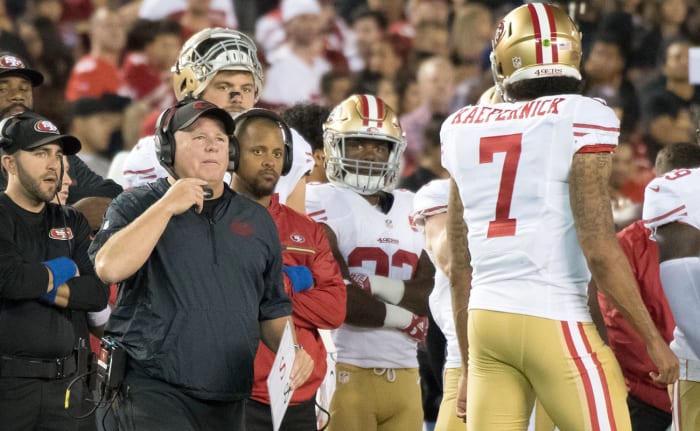
After playing under Chip Kelly at Oregon, Lowe (in red) worked for Kelly in Philadelphia and San Francisco.
Brian Rothmuller/Icon Sportswire/Getty Images
Lowe was in. He moved across the country to cut up film and fetch coffee, grinding one 15-hour day into the next. On Sundays he’d relay the offensive play calls from the sideline, often sending in the same schemes he’d run himself at Oregon. He found he liked it there, on the sideline; he loved teaching and motivating, and he could power through the grunt work.
The Eagles went a disappointing 7-9 that season, and when the front office fired the entire coaching staff Lowe followed Kelly to San Francisco ... where together they finished 2-14 in 2016. Kelly got another pink slip, and Lowe found himself again at a crossroad.
At 23, his NFL career in limbo, Lowe hung around the Bay Area, weighing what to do next. Then one night Forrest called. Instantly, Lowe could tell something had gone horribly wrong. “It’s Taylor,” the voice on the other end said.
For years Lowe had watched from afar as one of his best friends descended into the dark throes of addiction. Three surgeries—two on his left shoulder, another on a torn left-elbow tendon—had ended Martinek's college career after three seasons. The once-carefree linebacker ended up strung-out on painkillers, in and out of treatment centers, committing petty crimes, getting into fights, landing in jail, violating parole.
But by 2016 those around Martinek hoped he had made a permanent turn toward sobriety. He completed a treatment program and landed a sales rep job at a local marketing firm; his bosses were aware of his demons and supported his efforts to stay clean. Thanksgiving and Christmas passed without incident. Taylor even got a promotion.
The night of his relapse, Friday, Jan. 13, 2017, Martinek illegally purchased what he thought was Xanax and Oxycontin but instead contained a lethal dose of fentanyl, a synthetic painkiller, 50 times stronger than heroin, which accounts for more than half of all opioid-related deaths in the U.S.
Forrest, who shared an apartment with his old buddy, found Martinek unresponsive the next afternoon, his lips, ears, arms and shoulders all blue. Brian Martinek, a police chief who’d responded to countless calls like the one he received that day, arrived at the apartment to find familiar flashing lights. His 24-year-old son was dead.
Lowe got the call from Forrest, caught an early flight from San Francisco and was the first grieving visitor at the Martinek home that morning. Privately, he fell into absolute grief: If only I had been there. Been around. Put Taylor over my ascendant career.
The NFL grind—even the six-figure paychecks that awaited him if he were promoted to a full-time position coach—no longer seemed all that important. His brother, Trey, then 17, was playing at receiver for Jesuit High, where Brian Martinek was an assistant. Lowe knew he couldn’t leave them. He decided that day to come back home, to heal, to entrench in his community. “I was still searching for something,” he says. “And I was going to find it.” He told his mother, and she offered him her couch. “You are where you're supposed to be,” she said.
Lowe volunteered at Jesuit, working with the offensive skill groups, and all season he wore a pin bearing Taylor's face on his left breast, close to his heart. The following spring, in 2018, he found a bigger opportunity. There were reasons for the coaching vacancy at Parkrose High: the thin roster, the dilapidated equipment and the 23-game losing streak. But the same kid who responded to Chip Kelly’s challenge—You’ll never play a down!—saw opportunity in such despair. In his job interview Lowe told administrators, “0--23 is nothing; I can turn this thing around in one year.”
He had work to do. His best players didn’t know what a win felt like. Some were homeless or had lost parents or lacked the money for cleats. The weight room had only four barbells. The practice field was so barren it resembled concrete. Maybe 20 kids showed up for the first workout that summer; to build some basic football knowledge Lowe started giving quizzes with questions like, How many points is a touchdown worth?
“We were teaching them things,” he says, “so that after that we could teach fundamentals. But the biggest thing was not to make excuses. Ever.”
Lowe instilled discipline and accountability. He took money from his own wallet for team barbecues and helped players get to and from practice. He taught them the dimensions of the field, the number of downs and what red zone meant. For his first intrasquad scrimmage he used trash cans to simulate defenders since he didn’t yet have enough players. But they were his players, and he taught them how to stretch, eat better and move more efficiently, borrowing from Kelly at every turn.
Parkrose had finished 0-9 the previous year, allowing the most points of any 5A school and scoring the fewest—and then three all-league players graduated. The week of the Broncos’ 2018 opener they practiced on a field without lines. On the first snap of their first game under Lowe one player lined up two yards offside. The losing streak moved to 24.
If this felt like the football version of The Bad News Bears, what happened next seemed like a movie too. In its second game Parkrose hung 82 on Benson High, shattering the school record for points scored. Lowe expected a Gatorade shower, but that would have entailed his players knowing about the tradition. The Broncos finished 5-5, making the playoffs for only the sixth time in school history. Lowe got his sugar-water bath when Parkrose clinched a spot in the state playoffs. “One of the best moments of my life,” he says. Better than the national championship touchdown? “Way cooler.”
Still, Lowe’s mind would drift late at night back to Taylor, the friend he lost to drug addiction. Taylor was the reason he’d stay in Portland even after his success led to other, better offers. He’d take the longer odds, he reasoned, because he could make a greater impact.
Standing in Mr. Melzer’s Government classroom back in May, Lowe assessed the situation in an instant. Yes, he saw a gun; yes, that gun was real. He remembers Granados-Diaz’s eyes and how they widened like an insect’s and teared, announcing desperation, anger, confusion. The teenager whipped the shotgun around, turning it on himself as students scattered out the back of the room, shrieking. (Only in the Fab building did classrooms have two doorways.) “It wasn’t like a movie,” Lowe says. “It was real screaming-for-your-life-type stuff.”
He says he never considered ducking or hiding or running. He made a split-second decision: to grab for the gun rather than tackle Granados-Diaz. They wrestled for control, the college football star and the kid who called himself an outsider, who’d told classmates that his girlfriend had broken up with him and whose lawyer would later say in court that he suffered from depression.
Lowe tried desperately to direct the barrel away from both the stampeding horde and from his own face. He and Granados-Diaz knocked into a filing cabinet and spilled into the hallway, where Lowe finally snatched the firearm away, holding Granados-Diaz with his left hand and the shotgun with his right.
In the hall a teacher happened by and Lowe screamed out for her to call police. He remembers her sprinting away, shoes squeaking on the linoleum floors, yelling, “Active shooter!” In control, Lowe handed the gun to another teacher, who bolted back inside a classroom. He remembers seeing the football field and the track through the window, in the distance; he remembers walking Granados-Diaz slowly down the hallway, holding tight to the boy’s wrists, one hand on each of his, then guiding him to the floor underneath a security camera and a PARKROSE PRIDE sign. His anger began to melt, giving way to a compassion he couldn’t have expected.
The two had never met before, Lowe and Granados-Diaz. Sitting there on the ground, the menace fading from his face, the teenager looked scared, confused, troubled. He kept repeating the same thing, that he didn’t want to hurt anyone, that he only planned to shoot himself. “Nobody cares about me!” he screamed.
Lowe looked into his eyes. “I care about you,” he said.
“You do?”
Lowe says that broke his heart, seeing Granados-Diaz raise his head and return his gaze. “I do, bro!” Lowe said. “That's why I’m here. I got you, buddy.”
A dozen cops eventually barreled around the corner, guns drawn. (That part scared Lowe the most, as he tried to flip his school ID badge in their direction.) Officers pinned Granados-Diaz facedown, snapping handcuffs around his wrists as Lowe continued to console him.
Only later did it all start to sink in. “Like, holy s---,” Lowe says. “I just took a f------ shotgun from this kid.”
Lowe skipped the district track meet that afternoon. Instead, after meeting with police, he went back to his mother’s house, where his family found him to be remarkably calm. In those first hours he would return just two of the dozens of calls he received after news of the near catastrophe started scrolling across television tickers. First he dialed Kelly, who asked his former player what form he used in subduing Granados-Diaz.
“It’s like what you taught me on kickoff coverage, Coach,” Lowe responded. “Technique doesn’t ultimately matter. Just get him down by any means necessary.”
Then he called Brian Martinek. “Taylor was with me,” he said. “He was right there the whole time.”
In the weeks that followed Lowe would be commended by the U.S. Congress, the Oregon State Senate and the Portland police; he would be gifted Blazers playoff tickets by Damian Lillard and cited by Warriors coach Steve Kerr for his “remarkable act of courage.” He would also collect the district’s track coach of the year award, an honor he learned about the evening of the altercation. Meanwhile Granados-Diaz was charged with possessing a firearm in public and with reckless endangerment; he pleaded not guilty on May 29. (Police found only one shell in his shotgun.) He is still in custody, due in court on Aug. 23; he could face up to five years in prison.
Lowe hopes that one day he and Granados-Diaz can meet again, under different circumstances. But he’s not quite ready to reach out. Not yet.
It’s June, and Keanon Lowe can only shake his head as he traverses the same Parkrose hallway, touching the white walls. He can still see Granados-Diaz’s eyes widen, the other teenagers’ mad dashes toward safety. Their screams still echo in his ears.
This is his first time back in Mr. Melzer’s classroom and he can’t help but consider all the events that led him here. All the practices, the SEALs training, the extra reps. How he never expected to coach and yet became one. How his friend’s death shook him and led him home. How he took a job nobody wanted and showed a team and a school what might be possible. How he found himself at the center of the three biggest epidemics in modern-day America, confronting poverty and opioid addiction and gun violence, all before he turned 27. Heavy stuff.
He draws a direct line from all of that to the calamity he prevented. Kelly does too. “Keanon’s preparation for what happened,” he says, “has been ingrained in him for a long, long time.”
Lowe brushes off any talk about his being a hero. He doesn’t feel like one. “It still doesn’t seem real,” he says. “I was there for a reason, at the right time. I truly believe my entire life prepared me for that moment, not to flinch.”
The day after the shooting that never happened, Lowe returned to Parkrose to watch security tape of the incident, analyzing it like game cut-ups. He matched the footage from the hallway with his own time line, noting that while he went into the wrong classroom, Granados-Diaz exited the bathroom. As Lowe entered Mr. Melzer’s room, Granados-Diaz lumbered down the hallway, holding his shotgun the way a solider might, with both hands. And as Lowe asked where Granados-Diaz might be, the boy opened the door right next to him. On the footage you can eventually see them both spill back into the hallway before Lowe wrestles the shotgun away.
“I never thought about my life,” Lowe says. “This isn’t heavy on my soul. The universe has been working with me for a long time.”
He shrugs. “I was right where I was supposed to be.”
• Question or comment? Email us at talkback@themmqb.com.

































